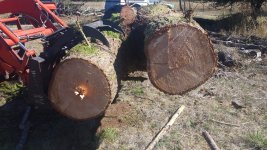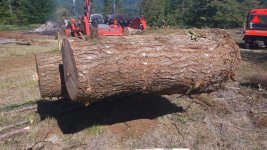rScotty
Super Member
- Joined
- Apr 21, 2001
- Messages
- 9,669
- Location
- Rural mountains - Colorado
- Tractor
- Kubota M59, JD530, JD310SG. Restoring Yanmar YM165D
Our Kubota M59 seems to lift within specs. It is rated at 4000# at the front bucket pins and half that at the bucket lip. Last Fall I picked up a 10 foot length of 30" concrete pipe by dangling if from chains running from the bucket hooks over the bucket lip and around the pipe. Then carried it with the bucket curled half a mile to where it was to be used. There's not much guesswork on the weight - that size pipe weight should be 2190 lbs. I was careful to take my time, go slow, and not let it get to bouncing - but that load is just within Kubota's operation specs. To the surprise of the swamper - and to my own relief - the tractor handled it without strain. Steering and balance seemed not much different from normal.
Over the years I've noticed that where this loader could stand improvement is in the bucket roll-back force when the lip is held in the neutral horizontal position - that's the most common position when sliding the bucket into a pile to load it. The bucket roll-back force in that position is adequate, but that's all it is.
I see no simple reason that roll-back force couldn't be designed to be a lot higher. After all, it's a local force out at the tip of the loader arms and doesn't stress the tractor or loader mountings. It might be deliberate though - for instance the real limitation might be the strength of the SSQA adapter. Maybe I'll look at that....
Hmm....I just looked at the "specifications of the loader" on page 7 of the operating manual where Kubota shows drawings of the geometry they used to calculate the loader forces. The drawings of the bucket linkage geometry are not correct, and that means any force calculations based on that geometry are also incorrect. If that page originated from the design group, it would help explain the odd weakness in the bucket roll back force.
Oh well, I guess it doesn't really matter. That's all theoretical stuff and worth what it cost. There's plenty of muscle in that loader for anything we've wanted done.
rScotty
Over the years I've noticed that where this loader could stand improvement is in the bucket roll-back force when the lip is held in the neutral horizontal position - that's the most common position when sliding the bucket into a pile to load it. The bucket roll-back force in that position is adequate, but that's all it is.
I see no simple reason that roll-back force couldn't be designed to be a lot higher. After all, it's a local force out at the tip of the loader arms and doesn't stress the tractor or loader mountings. It might be deliberate though - for instance the real limitation might be the strength of the SSQA adapter. Maybe I'll look at that....
Hmm....I just looked at the "specifications of the loader" on page 7 of the operating manual where Kubota shows drawings of the geometry they used to calculate the loader forces. The drawings of the bucket linkage geometry are not correct, and that means any force calculations based on that geometry are also incorrect. If that page originated from the design group, it would help explain the odd weakness in the bucket roll back force.
Oh well, I guess it doesn't really matter. That's all theoretical stuff and worth what it cost. There's plenty of muscle in that loader for anything we've wanted done.
rScotty


